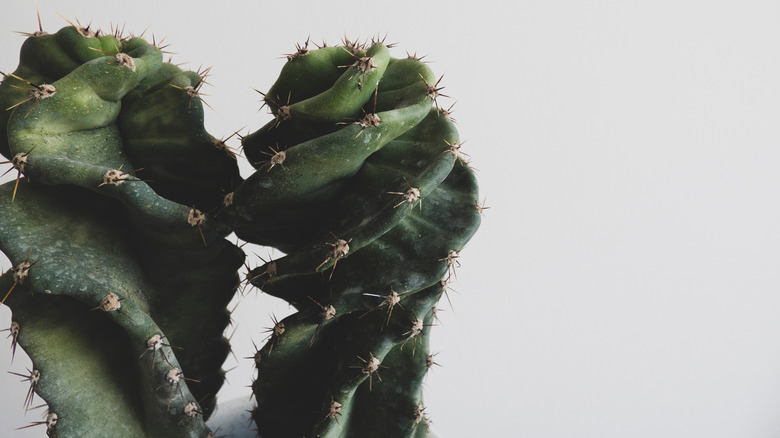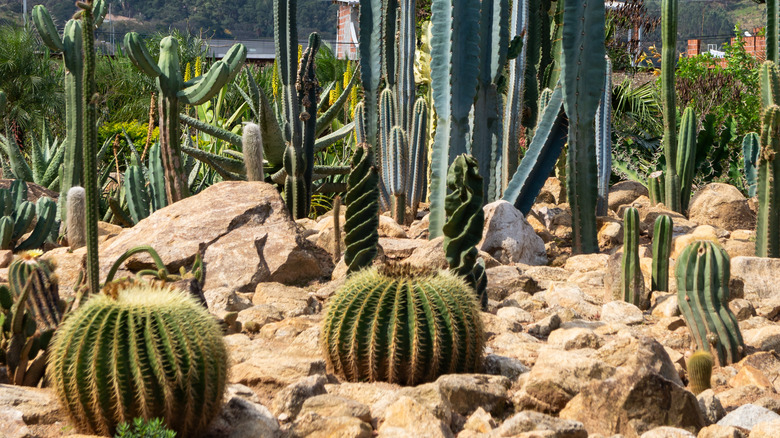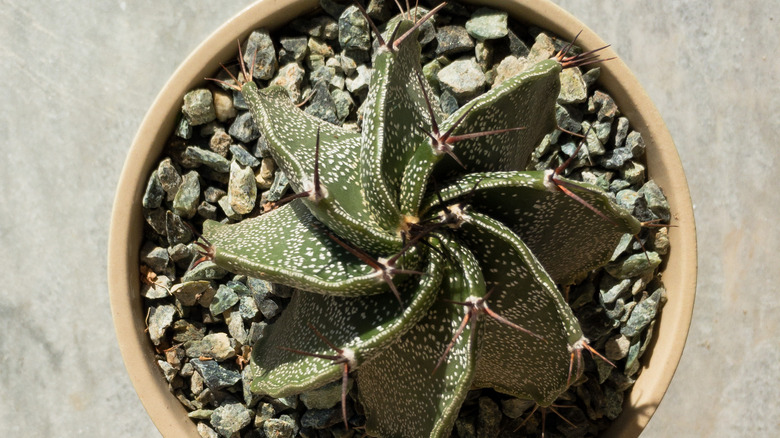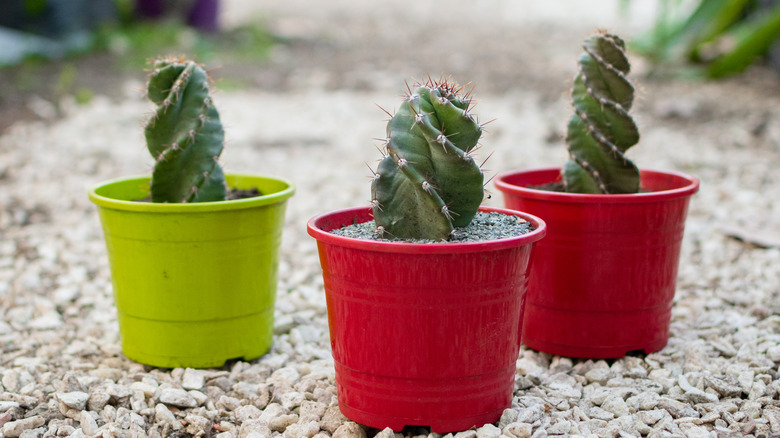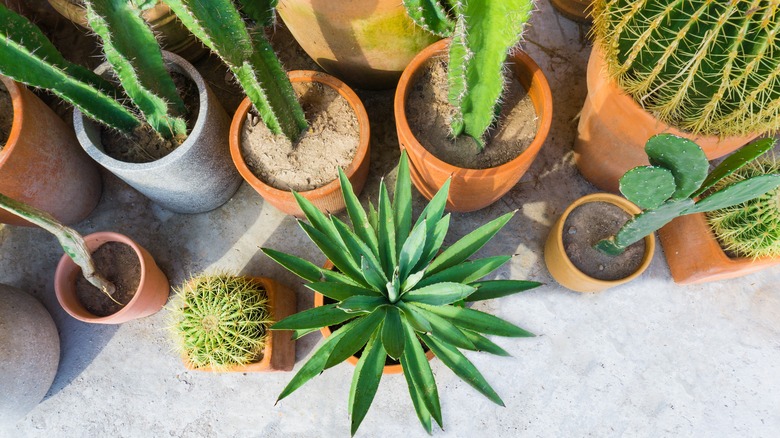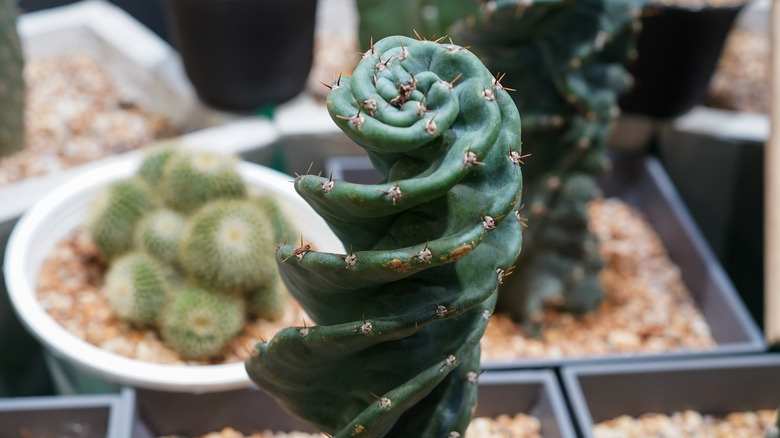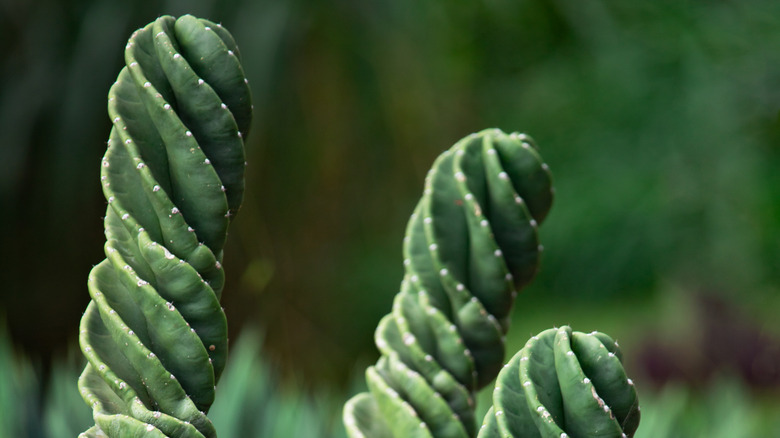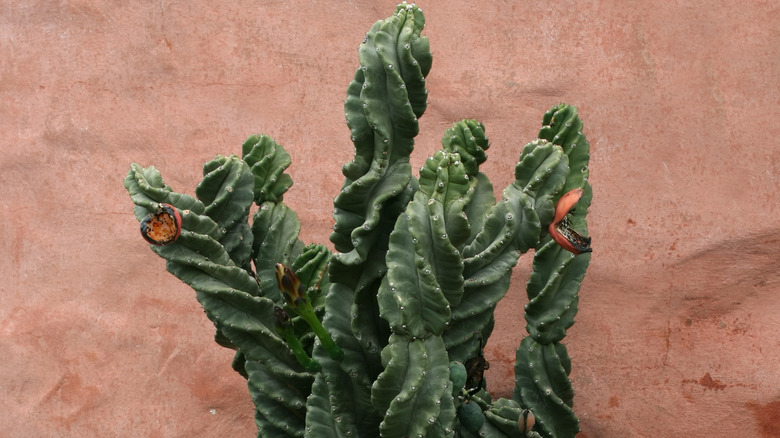How To Care For A Spiral Cactus
This stunning spiral cactus is a rare find with a, dare we say, "twisted" past. Known as both the cereus forbessi spiralis and Cereus peruvianus spiralis, the true origin of the spiral cactus remains a little unclear, though it is thought to have been imported first from Peru to Europe in the 1980s, according to Dave's Garden. Then again, some believe the plant also could have come from Brazil or Argentina. While the twisted cactus was originally bred using a propagated clone branch from the original plant, almost all new plants are grown from cultivar seeds. Cultivars are plants that have been bred to produce certain traits through careful control.
Don't panic if your nursery cactus seems to lack that iconic twist at first — spiraled cacti only begin to spiral when the plant stands at about 4 inches, as noted by the Plantophiles. But this prickly plant won't stop there. World Of Succulents reports that the spiraled cactus can achieve a height of 16.5 feet! While their origins are dicey and a little hard to fully understand, the good news is that similar to other cacti, the twisted cereus is an easy plant to grow at home either in a pot or in your xeriscaped back yard. Our guide will tell you everything you need to know about raising this quirky, impossible to resist cacti.
How to use spiral cactuses in the garden
The spiral cactus can thrive in indoor and outdoor environments, but there are some key differences in its cultivation. Indoor planting for cacti is a great choice if you don't live in an arid desert environment, but these robust plants can make it work in temperate environments as well. These unconventional desert plants will look right at home next to other cacti and succulents. We recommend placing them next to plants of varying sizes and shapes, creating an out-of-this-world vignette.
Other plants that thrive in similar conditions are agave, Prickly Pear cacti, and yucca plants. The twisted cactus can make for a stunning centerpiece or unusual accent when paired with these other desert plants. Be sure to keep them away from water features like fountains and ponds, as the additional moisture can cause root rot and waterlogging. No matter how you style your garden, the rare twisted cactus is sure to stand out.
How to grow spiral cactuses
Indoor planting for cacti is a great choice if you don't live in an arid desert environment. If you are doing a potted plant, you can keep your cactus in or out, which will allow vertical growth and achieve some pretty fantastic heights. If you're hoping for the gorgeous candelabra-like branching structure, you will have to plant your twisted cactus directly in the ground or in an extremely wide pot.
To grow a happy spiral cactus, you'll need a few things in addition to a place to plant it. Be sure to use the right soil. If you live in the desert, your cactus will thrive in the natural soil available in your yard, but if not, be sure to get a soil that is gritty and coarse-textured, according to Plantophiles. This will help the plant to drain water more quickly. Next, if you're growing from a propagated plant rather than seeds, you'll want spine-proof gloves and full-arm coverage while you plant the cactus to prevent painful pricks. To propagate the spiral cactus, cut a branch or pad in springtime, then plant the cutting in moist, well-drained soil, as recommended by Succulents Addiction. The new plant will begin to take root, and you'll have a fresh start with your twisted cactus.
How to care for a spiral cactus
If you're already familiar with the world of cacti, it should come as no surprise that these plants are sturdy, hardy, and fairly low-maintenance. That's not to say that they don't require some tender love and care but can be less intimidating than many other plants. With a few helpful tips, you'll have a thriving spiral cactus.
First, be sure to avoid overwatering because there's nothing a cactus hates more than being overly wet. Happy Sprout recommends watering the plant regularly, especially in the peak growing season, which lasts from spring to the end of summer. However, only water the plant when the soil is completely dry, or else the plant can become waterlogged and begin to rot.
During the growth season, you can fertilize the plant once or twice a month. Be sure to plant your twisted cactus in an area that will receive both direct and indirect light. This will help to cultivate the gorgeous blue-green color and avoid your plant getting a sunburn. That's right, just like people, plants can become sunburned, too. Not only does that cause tan and rough spots on your plant, but can impact its long-term health as well. That's what makes it vitally important when planting outside, either in a pot or directly into the soil, to make sure you choose a spot that receives a mix of direct and indirect sunlight.
Spiral Cactus Varieties
While the spiral cactus belongs in the much larger world of cacti, it is a part of the Cereus family, which contains over 30 plant species. It goes by both Cereus forbessi spiralis and Cereus peruvianus spiralis, but this distinction is more about its mysterious origins rather than a genetic difference. Cereus cacti, as Succulent Alley notes, are known for their ability to thrive in drought-prone areas, wide-set ribs, columnar branches, and pronounced spines, all originating from South America. In addition to the spiralis, here are a few other popular cacti from the family Cereus:
- Cereus jamacaru is an excellent cacti for apartment living but will only blossom and fruit if left outside to be pollinated by bees and night-flying insects.
- Also known as the Peruvian apple cactus, the Cereus peruvianus produces a desert apple most similar in appearance to a dragonfruit — red flesh and black-and-white dotted fruit.
- The Cereus aethiops takes on a more menacing appearance than its family members with striking black spines, akin to a sea urchin.
- Thought to possibly be the origin of the spiral cactus, the Cereus forbessi produces blue-green columnar spines and can grow as high as 7 meters.
- Cereus stenogonus can be found in the wild in Uruguay, Paraguay, and Argentina and has stunning white-pink blossoms that bloom only at night.
Are spiral cacti toxic?
Cereus spiralis are not toxic to people or pets, but that doesn't mean they are totally family-friendly. Like most cacti, the twisted cactus is covered in prickly spines that protect water in the plant from predators. These are extremely painful if they become lodged into you or your furry friend's skin. It's best to place these far out of the way or on a pedestal if you have small children or pets in the home.
The spiral cactus is a heavy bloomer, especially if grown in nature, Bloom Box Club notes. During the summer, typically from June to August, your cactus will produce stunning white and pink flowers, though this is less likely if you're growing an indoor plant. Following the end of the blooming season, and if the flowers have been pollinated by our busy bee friends, red ornamental fruits will appear in place of the flowers. Because these plants are still quite rare, there is little to no info on the taste of these fruits, so use caution if you decide to harvest and use them.
How to repot spiral cacti
If your spiral cactus has been in its soil for a long while, it will begin to lose essential nutrients, which means it's time to repot. You'll also need to repot if your plant has outgrown its original pot, either by failing to thrive or becoming too tall and heavy to be supported. Plan on repotting your cereus spiralis every other year, according to Happy Sprout.
When it's time to repot, you'll want to take the plant up by the root. Take caution to avoid getting stuck with a spine, and always wear gloves when handling your spiral cactus. Be sure to shake and clean the roots thoroughly, so they don't transfer any of the old soil to their new pot. You want to transfer the cactus to a pot of moist, not wet, fresh soil. If you're repotting during the spring or summer, you can add some cactus fertilizer to help your cactus thrive in its new environment.
Common issues for spiral cacti
While the sharp spines on cacti can prevent a lot of predators and pests from harming them, they are susceptible to a few unwelcome guests like mealybugs, according to Dave's Garden. Mealybugs are white insects that cling to plants and suck sap and nutrients from them. If you noticed white frothy patches or creepy crawlies on your twisted cactus, give it an aggressive spray down with some water to dislodge the invaders. If you continue to see evidence of pests, try out an insecticidal soap — just be sure to read all warning labels before applying.
Like many cacti, Cereus Spiralis is susceptible to root rot, which can kill a plant. Root rot is caused by waterlogging due to poor drainage and overwatering. If you notice soft or darkened roots of your cactus, cut the damaged segments away to preserve the life of the rest of the healthy plant. While this can usually solve the problem, you may decide it's best to propagate a new, healthy plant start, which you can do by cutting and planting a piece of the existing plant in fresh, moist soil.
